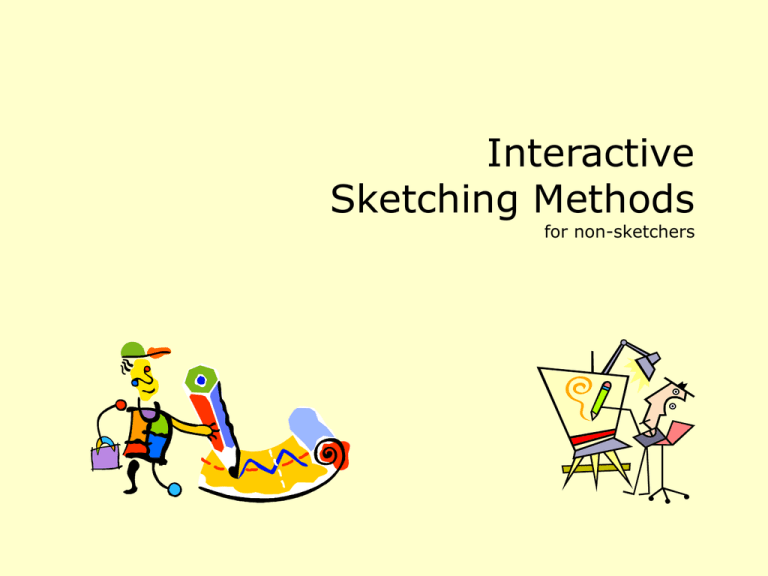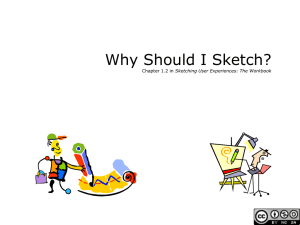Vanilla Sketch
advertisement

Interactive Sketching Methods for non-sketchers Part 1. The Vanilla Sketch Captures: • an essence of an idea • a moment in time • the look of an interface • multiple variations of the concept Carloyn Snyder,Paper Prototyping (2003) Carloyn Snyder,Paper Prototyping (2003) Morgan Kaufmann Morgan Kaufmann Susannah McPhail Technique: Just Draw Something Don’t worry about aesthetics • the sketch is for your eyes and • the sketch is a social thing: a conversational prop that engages others in talk about your ideas But if you want to learn how to draw • sketching courses o arts, industrial design, community courses… • books o Drawing on the Right Side of your Brain by Betty Edwards Technique: Just Draw Something Scribble drawing • sketch anywhere, anytime, • sketch in the dark (while watching a movie) • speed sketching (1 minute or less) Trick • draw only essentials • scribbles suggest details Time to draw: 30 seconds Technique: Just Draw Something Exercise: draw this powerpoint screen • you have 45 seconds Time to draw: 45 seconds Technique: Tracing Basic idea • copy / trace the fixed elements of an existing interface/screen • leave your design space empty Technology • camera, photograph, tracing paper or • Photoshop or equivalent o trace over image on a separate layer Drawing skill required • almost zero Bill Buxton Sketching User Experiences, Morgan Kaufman Figure 96, p 279 Bill Buxton Sketching User Experiences, Morgan Kaufman Figure 96, p 279 Bill Buxton Sketching User Experiences, Morgan Kaufman Figure 96, p 279 Bill Buxton Sketching User Experiences, Morgan Kaufman Figure 96, p 279 Generate blanks for your designs Screen can be filled in, phone is constant Technique: Hybrid Sketches Mixes full and low fidelity elements Full fidelity portions: • fixed design elements Low fidelity portions • speculative components Contrast • makes certain parts of sketch stand out over others Hybrid Sketches Lo-fi = speculative… Detail = fixed elements Bill Buxton Sketching User Experiences, Morgan Kaufman Figure 96, p 279 Hybrid sketches Bill Buxton Sketching User Experiences, Morgan Kaufman Figure 98, p 281 How much fidelity do we really need? How much fidelity do we really need? Bill Buxton Sketching User Experiences, Morgan Kaufman Figure 105 (from Scott McLaoud, Understanding Comics, p30) How much fidelity do we really need? Constrained resolution • no higher than required to capture its concept Consistency with state • rendering fidelity matches the actual state of development of the concept Suggest & explore rather than confirm • suggests and provokes what could be A catalyst • evokes conversations and discussion Picasso’s The Acrobat Picasso’s Engravings for Carmen Picasso’s Sleeping woman Picasso’s Woman with yellow hair Picasso’s Don Quixote Computer Telephone Last Name: First Name: Phone: Place Call Help Technique: Annotations Marks that augment a sketch • directly on sketch • as layer o tracing o Photoshop layer • over dynamic media Bill Buxton Sketching User Experiences, see pages 175-185 Technique: Annotations Textual notes • • • • name and / or explain things add detail lists of items questions / issues about design… Graphical marks • connects notes to sketch elements • relates sketch elements • show dynamics of elements or interaction over time… Bill Buxton Sketching User Experiences, see pages 175-185 Photo of Steve Langley Photo of Steve Langley Bill Buxton Sketching User Experiences, Morgan Kaufman Figure 95, p277 Bill Buxton Sketching User Experiences, Morgan Kaufman Figure 64, p 174 portion of a page from Saul Greenberg’s sketchbook Vanilla Sketch Examples -screen snapshot 1From Carloyn Snyder’s Book Paper Prototyping (2003) Morgan Kaufmann p31 Sketch examples 1From – design variations Carloyn Snyder’s Book Paper Prototyping (2003) Morgan Kaufmann, p350 Sketchbook examples – details to prototype buddy bugs - sketches and final prototype, by former 581 student Susannah McPhail Exercise –tracing / copying Choose a handheld device • cell phone, PDA, watch… Photograph the device and screen contents • choose a good angle/size • take several photos of it at different angles/sizes just in case Trace over the phone • On paper, or in sketching program • capture its essence, not literal high fidelity details







